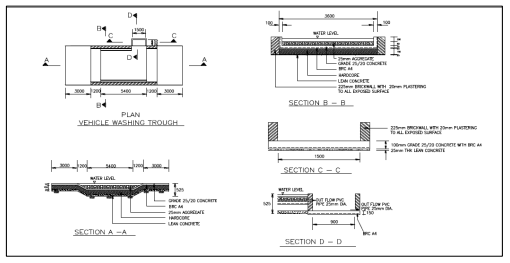Increased traffic volume is expected during implementation of the Project. The presence of heavy and slow-moving vehicles may obstruct the movement of other vehicles plying the transportation route. One of the principal challenges in traffic control is accommodating traffic in a safe and efficient way. Efficiency can be viewed as a measure of movement levels relative to the objectives for a particular transportation system as well as the finances required for its operation.
Target
Conduct traffic and transportation activities in a safe and efficient way
Standard Operating Procedures
12.1 TRAFFIC AND TRANSPORTATION (LAND)
12.1.1 Erect suitable speed limit and safety signs at the project entrance (i.e. development site, overburden dumping ground and borrow pit) to notify public road users.
12.1.2 Strictly obey speed limits and other traffic laws.
12.1.3 Stabilise and pave all entrance/exit roads to the site for a suitable distance from where these access roads join existing paved or public roads.
12.1.4 Construct a wash bay / wash through with a silt trap of not less than 1m x 1m x 1.2m (depth) in size (based on Drawing design) at the location shown in the approved EIA/AEC. In addition, construct the washing facility with grating / rumble surface and silt trap.
12.1.5 Conduct periodic maintenance on the silt trap. Prohibit disposal of sediment removed from the silt trap into drainage or watercourses.
12.1.6 Refer to requirements from the Local Authorities for transportation routes and/or JKR for access involving road reserves (application of wayleave).
12.1.7 Obtain consent from private landowners if access is required across their land.
12.1.8 Clean tyres and undercarriage of transportation vehicles at the wash bay / wash through before leaving the project site to avoid formation of bulky deposited dirt and earth on public road surfaces.
12.1.9 Remove sediment or mud tracked out on public roads at the end of the same work day by sweeping, shoveling or hosing.
12.1.10 Avoid off-site transportation activities during peak traffic hours as stated in the AEC/MD.
12.2 TRAFFIC AND TRANSPORTATION (SEA)
12.2.1 Install and use navigation lighting on vessels.
12.2.2 Install navigational lights and beacons at the marine working area.
12.2.3 Strictly adhere to the MTRA report as approved by JPDS in relation to vessels/boats/barges passage or marine activity.
12.2.4 Comply with navigation restrictions for all construction vessels that are enforced by relevant authorities.
12.2.5 Refer to JPDS regarding the navigation area and where the ship should be anchored.





